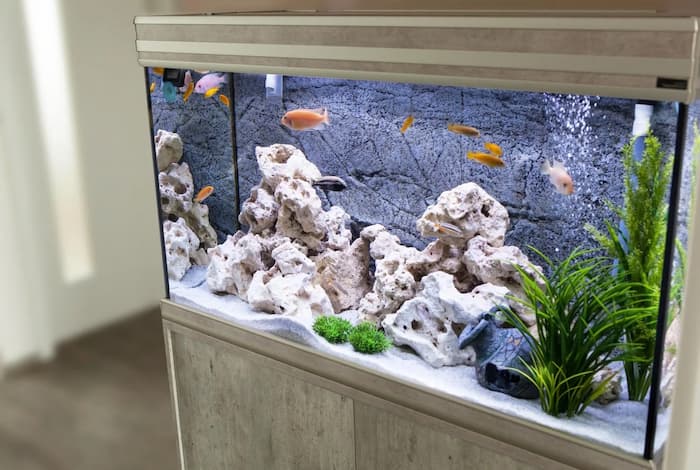Transporting an aquarium is obviously an important task for you if you are reading this guide. How to keep your aquarium not only intact but also without disturbing its microclimate? How to transport the fish properly so as not to harm them?
It is for you, these are the questions we answer in our material.

You’ll Need These Materials To Move A Fish Tank
First of all, prepare the tools, some of them are specific and you will need to buy them in advance, others are quite common and every day.
- Plastic Cases for the Fish. The best storage items for fish are plastic bags, plastic containers, or buckets. These fish need ample air, so you must provide it in the bags. Plastic containers need firm covers with tiny holes. Buckets are suitable for storing aquatic plants.
- Adhesive. Some bucket covers or plastic lids might not stay shut, so using a light adhesive like duct tape or rubber is best. You can also use a large band (if you can find one) to hold them tightly.
- Fishing Net. When moving a fish tank, siphon your pet fish from the tank. For this task, you can use an untreated cloth net made from a durable material (if you have one available), a plastic basket/sieve, or a fishnet.
- Aquarium Water Containers. Yes, this is key to maintaining a microclimate familiar to the fish – keep some of the water in. Mini water barrels, jerry cans and any clean containers of sufficient volume that you have with a tight lid are suitable for this purpose.
- Supplies for the Aquarium. The aquarium will be transported without water, so you can think of many ways to pack it. Bubble wrap, towels, sheets, plaids and boxes for the mechanical components. If possible, you can order a custom sized box, place the aquarium in it and fill it with packing foam or packing peanuts. And inside you can put a filter, heater and decorative items.
Steps to Move An Aquarium
Step 1: Remove the Fishes
- First of all, fill a clean fish carrier with some water from the aquarium. Use a fish net, catch the fish one by one and transfer them to the transport container.
- If there are many fish, there should be several containers at the rate of 3 litres of water for 1 adult goldfish or 5-7 small fish.
- Cover the containers with a lid with prepared small holes to allow air access.

Step 2: Drain Some of the Water
- Ideally, save 75% of the water from your aquarium, which is not always convenient or possible. We recommend that at least 50% be transferred to a new location.
- Drain the transport water into your prepared containers and close tightly.
- If the container has a wide enough neck, you can also put the plants from your aquarium in it. It is not necessary to use a separate container for this.
| Getting a Moving Quote is simple. It's fast & easy GET FREE QUOTE NOW |
Step 3: Remove the Equipment
- Unplug the filter, heater, and other equipment and remove it.
- Rinse and clean the equipment and leave it to dry.
- Afterwards, pack it in a box, plastic container or inside the aquarium itself.
Step 4: Pack up the Plants and Décor
- If you pack the plants separately, take them out into a separate container and add a little aquarium water to cover the plants. Cover it with a tight lid.
- You can now drain the remaining water for convenience.
- Take out and rinse all the decor, dry and pack it.
Step 5: Packing the Aquarium
- Clean the inside of the aquarium, rinse and dry it.
- Then wrap the corners with special cardboard protectors or folded cloth and tape if necessary.
- Wrap the walls of the aquarium with bubble wrap, cloth, and, if possible, pack it in a box or a special crate. Fill the gaps between the aquarium walls and the box with transport foam, peanuts, or plaids.
Step 6: Transporting the Aquarium: Important Nuances
- The most important thing is to minimise the time the fish spend in an unfamiliar environment. Therefore, do not prepare in advance by disassembling the aquarium, but immediately before transport. It is better that the aquarium is transported separately from all things for the same reason.
- Transport the aquarium separately from other items for safety against splashing water. Even with tight lids on all containers, this can happen.
- Secure all containers of liquid and fish during transport to keep them upright. This can be done by sharing large containers with smaller ones, keeping the containers close together and filling the gaps between them with cushioning material.
- Careful behaviour on the road, avoiding bumps and driving at a slower speed if possible.
Step 6: Installation of the Aquarium at the New Location
- The most important thing is to do it right away to provide the fish with the necessary oxygen and a comfortable temperature and let them adapt.
- The aquarium is assembled in the reverse order from the preparations for the move:
– installing the aquarium
– decoration installation
– fill part of the water
– place plants
– install filtration and heating equipment
– top up the remaining water
– put the fish in the aquarium - Since the aquarium is usually filled with clean water that has been pre-treated by filtration, sedimentation or purification, it is possible to bring the aquarium to its full volume later, not immediately, if you have brought about 50 percent of the initial water.

Pro Tips
- Handling Different Species: Before moving in, study the information about the fish you have and consider their characteristics. For example, guppies are very sensitive to water changes, angelfish have very delicate fins that can be easily damaged, and cichlids can be aggressive and should be transported separately.
- Adjust pH: Check the pH level of the water before adding fish and adjust it gradually (no more than 0.2 per day) with pH buffers to avoid shocking the fish.
- Working with Salt and Freshwater: In saltwater aquariums, mix and aerate new saltwater at least 24 hours in advance to stabilise the salinity; in freshwater aquariums, make sure the chlorine is removed before adding new water.
If you need help with moving your fishtank or any kind of long distance moving, call (800) 919-6332 to talk to the experts at A Plus Moving Group – moving company in Charlotte, serving all the USA. We are ready to help you anytime!





